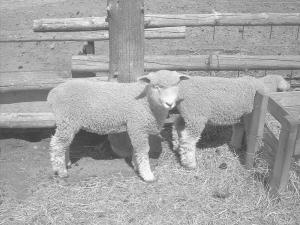2004 - Volume #28, Issue #1, Page #22
[ Sample Stories From This Issue | List of All Stories In This Issue | Print this story
| Read this issue]
Business Is Booming For Mail Order Meat
 |
Carol Pasheilich and Maggie Howard, of Tawanda Farms at Montague, Calif., sell their Murray Grey beef and Romney lamb to loyal, repeat customers. They fill their orders by delivering "quick frozen" cuts, via Federal Express.
"This is our third year selling lamb and it's definitely a seasonal product," Pasheilich says. "This year we are projecting we will sell about 50 lambs between mid-September and the end of December. Volume has been steadily increasing and we have about 90 per cent repeat customers. It is our first year for steers and it is our repeat lamb customers who are trying the beef so far."
According to Pasheilich, they offer both whole and half-lambs, as well as halves and quarters of beef, but most of their orders are for select cut "gourmet packages" that average 15 lbs., for special occasions.
The women have a 120-acre farm where they run 75 ewes and 15 cows. They also sell some hay as a cash crop, and boost their income by marketing breeding stock, wool and machine washable sheep pelts.
Direct marketing provides an opportunity for the women to educate their clients and develop a strong loyalty. They send out a newsletter that explains their sustainable farming practices, the health benefits of eating meat, particularly grass-fed meats, and they also share easy and delicious recipes they've collected.
To establish a bigger clientele, the partners rented mailing lists for high-end cooking magazines and sent out promotional material to 3,000 people, initially. As a result, they reaped about 30 orders. But rental of mailing lists can be very costly, they say.
The ladies price their meat at $236 for a whole lamb, promising 50 lbs. of meat. The various individual lamb cuts range from $4 to $9 per pound. Their beef price averages about $4.50 per pound and ranges from $2.50 per pound for ground beef, up to $17 per pound for prime cuts.
The women base their meat prices on a formula that takes into account all of their expenses including feed, veterinary supplies, packaging, shipping and marketing. They divided their total costs by the number of head involved, calculating a break-even cost per ewe and per cow, and added what they felt was a reasonable profit for their trouble. They took that figure and divided it by the pounds of meat produced, to figure their per pound end price.
Because of the shipping they needed to do for restaurant and interstate orders, they had to have their slaughtering done by a USDA approved facility, rather than a state facility. This, they say, accounts for as much as one-third of their costs.
Pasheilich and Howard use Styrofoam containers and cardboard shipping boxes with dry ice and frozen gel packs.
The ladies are in the process of setting up a website so they can expand their mail order business to include the internet.
Contact: FARM SHOW Followup, Carol Pasheilich and Maggie Howard, Tawanda Farms, 935 Lichens Rd., Montague, California 96064 (ph 530 459-0966; email: tawandafarms @juno.com).

Click here to download page story appeared in.

Click here to read entire issue
To read the rest of this story, download this issue below or click here to register with your account number.




